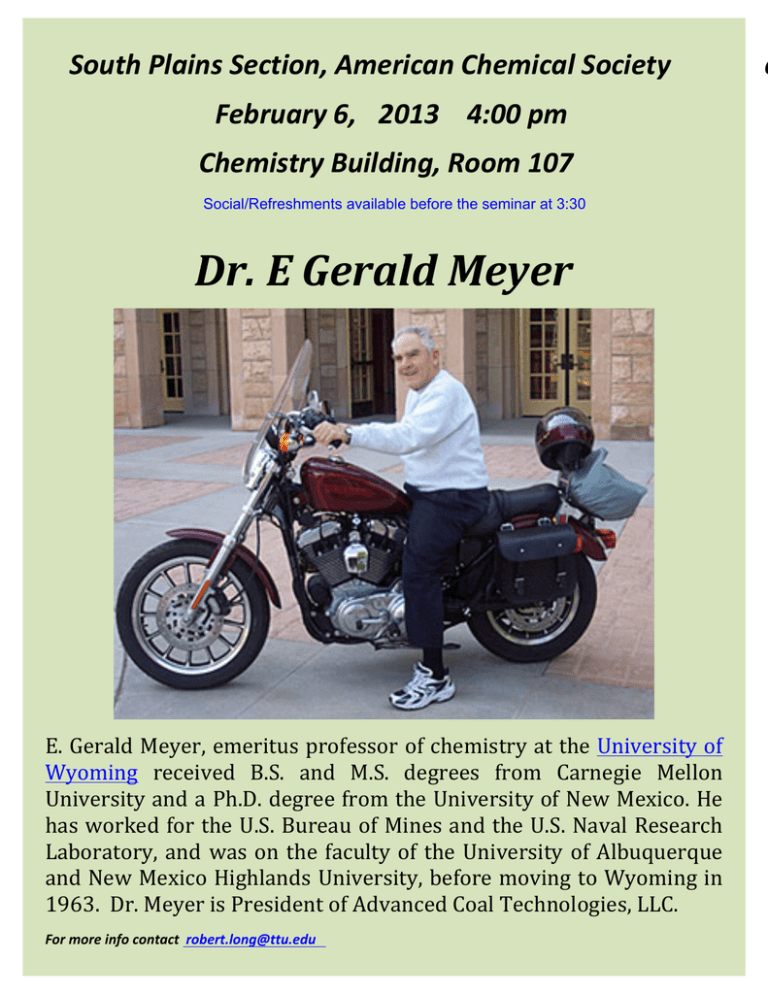Document 11321116
advertisement

South Plains Section, American Chemical Society February 6, 2013 4:00 pm Chemistry Building, Room 107 Social/Refreshments available before the seminar at 3:30 Dr. E Gerald Meyer E. Gerald Meyer, emeritus professor of chemistry at the University of Wyoming received B.S. and M.S. degrees from Carnegie Mellon University and a Ph.D. degree from the University of New Mexico. He has worked for the U.S. Bureau of Mines and the U.S. Naval Research Laboratory, and was on the faculty of the University of Albuquerque and New Mexico Highlands University, before moving to Wyoming in 1963. Dr. Meyer is President of Advanced Coal Technologies, LLC. For more info contact robert.long@ttu.edu c Coal as a Raw Material is Green Chemistry Coal is the most abundant energy source in the world. In the U.S., 94% of the fossil fuel reserves are coal. The coal in the Powder River Basin of Wyoming has a greater energy value than all the oil in the Middle East. Today coal is used to produce well over 40% of the nation's electricity. However, coal has a low hydrogen content, is a solid, has much variability, and contains potential pollutants. To reduce the difficulty of using coal, certain specialized shipping methods (unit trains) are used, boilers are built for each type of coal, the pollutants SOx and NOx are removed after combustion by scrubbing and catalytic conversion. Thus, coal usage typifies conventional processing methods. Is there any "green" technology for processing coal? We believe the answer is "yes": the “Coal21st”™ Process. The “Coal21st”™ Process concept is simply, why not apply the principles of oil refining to coal? In oil refining, the crude petroleum is hydrocracked thermally and catalytically to produce a slate of products (naphtha, gasoline, diesel fuel, kerosene, heating oil, fuel oil, asphalt, coke), the total value of which is greater than the cost of the crude oil plus the cost of refining. Also, refining removes pollutants such as sulfur. Thus, oil refining is actually both a value-­‐added technology and a "green" technology as it both increases the value of the raw material and eliminates the pollutants in the raw material before sending the products to market. The hydrocracking of coal is a more difficult chemical process due to the chemical nature of coal, but it has been accomplished using the patented “Coal21st”™ Process. The technology involves heating powdered coal with an internally produced, hydrogen-­‐rich gas at a very high rate to about 850 degrees C at a pressure of about 33 atm and limiting the hydrocracking reaction to a very short time (about 100 ms) before quenching. The resultant (solid) char and gases are then separated; the gases are sequentially condensed, and the noncondensable gas, methane, is subjected to a partial oxidation to produce hot CO and H2, which are used to heat the coal and provide the reducing, hydrogen-­‐rich gas for the basic hydrocracking of the coal. The slate of products includes naphtha, benzene, toluene, xylene, a chemical feedstock, sulfur, ammonia, and char. The char is a uniform, high heat value fuel that, because of its porous structure, may be used as an adsorbent or as semicoke. It is uniform regardless of the starting coal and has has 85% of the sulfur and 70% of the nitrogen removed, which eliminates scrubbing and catalytic conversion. The CO2 output is 2.8% based on the carbon in the coal used. Coal21st Process basically views coal as a raw material (just as oil is view as a raw material) which produces a slate of value-­‐added products. The economics of coal refining are much better than those of oil refining since the products in both cases are petrochemicals which are priced with oil, but in coal refining the feedstock, coal, is much cheaper than oil which provides a better margin. A joint venture with a Chinese firm is underway to build the first “Coal21st”™ plant in China. 4 pm 2/6/13 Texas Tech University Chemistry Rm 107 For more info contact robert.long@ttu.edu




